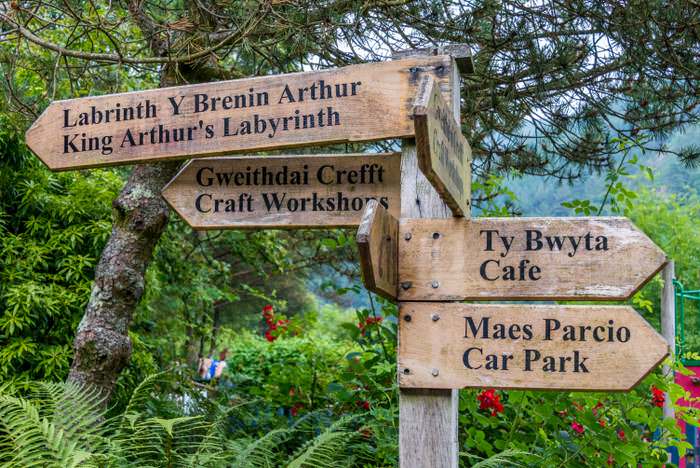As you drive through the lush green Welsh countryside you’ll see gray, slate-covered hillsides towering over misty valleys. These Welsh mountains are riddled with abandoned mine shafts that penetrate deep into their heart. This atmospheric backdrop, and the crumbling stone castles that dot the Welsh countryside, have fuelled many ancient Welsh legends. It doesn’t take much imagination to see red fire-breathing dragons flying overhead. And you wouldn’t be surprised to see knights in mail armor on horseback, clip clopping across the cobblestones through Wales’ small towns.
One tourist attraction, deep in the mountains of Southern Snowdonia, brings the legends of King Arthur to life with a walk through an old slate mine. And for mine aficionados, you can tour higher levels of the same deserted slate mine to learn about this hard occupation.
Driving along the winding forested roads of the A487, at the foot of Braich Goch Mountain, we turn a corner and suddenly come across a sign that proclaims “King Arthur’s Labyrinth”. We turn into the parking lot. Here we’ll meet King Arthur, Merlin, a ferocious dragon, a bearded giant, and we’ll see a medieval battle and hear numerous other Welsh fables, all in one dark slate mine tunnel.
After getting our tickets, we assemble at the mineshaft entrance to King Arthur’s Labyrinth, hard hats on heads. Entering the lengthy slate mine, our journey through the time of King Arthur begins. The temperature immediately drops by 10 degrees and it suddenly becomes pitch black.
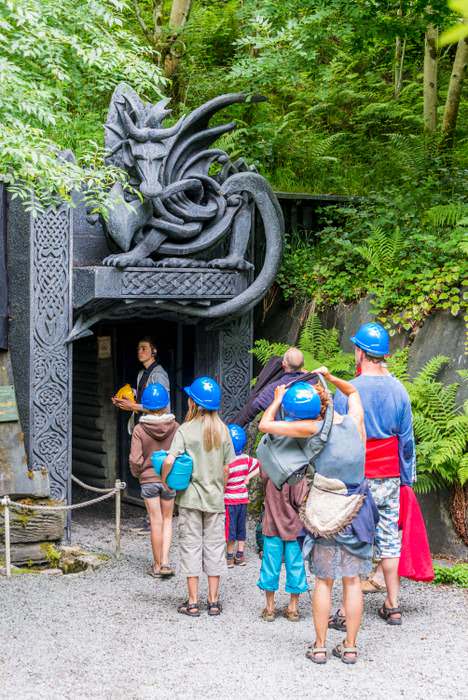
This picture shows us assembling at the mineshaft entrance to King Arthur’s Labyrinth, hard hats on heads. Photo: Linda Popovich
Sitting in an ancient longboat, a mysterious hooded boatman ferries us across an underground river to the Island of Avalon, where pagan gods and magic rules. According to legend, this is where Merlin took a dying King Arthur to be restored to health.
We trudge through the dimly lit slate tunnels, stopping every few hundred meters at vast caverns that recede off into the darkness. The caverns measure 50 meters wide and 25 meters high, and have slate pillars that support the roof. The caverns are decorated with dramatically lit dioramas where we listen to ancient stories. It’s like walking through a Tolkien movie set.
The first scene, Dinas Emrys, tells of King Gwrtheryn, who meets a sorcerer named Merlin. The magician tells the king about his visions. Beneath the mountains of Dinas Emrys, Merlin says, a white and a red dragon are fighting. The white dragon represented the Saxons, and the red dragon, the Britons. Although the white dragon was stronger, the red dragon will have his day, said Merlin. Merlin foretells that a future king will drive out the Saxons and that his name will be Arthur.
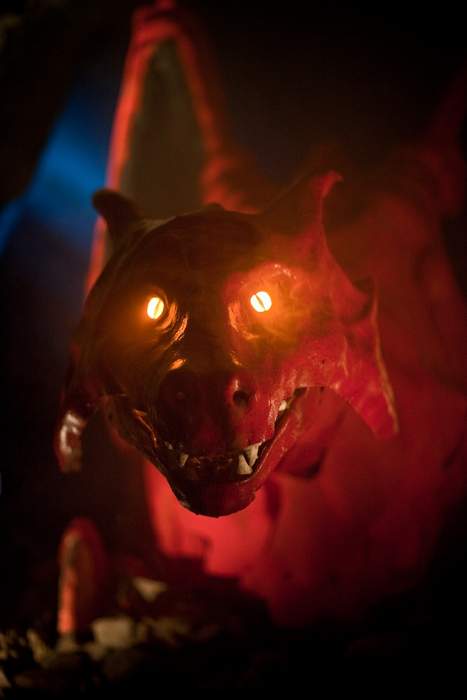
The red dragon of the Britons. Although the white dragon was stronger, the red dragon will have his day, said Merlin. Merlin foretells that a future king will drive out the Saxons and that his name will be Arthur. Photo: Courtesy of King Arthurs Labyrinth
Another stop tells of The Head of Bran, another intriguing Arthurian legend. Bran the Blessed’s head had been buried in the White Mount in London, and its supernatural powers protected Britain from invasion. King Arthur dug up Bran’s head, to show his people that their defense lay with the power of his army, and not the magic reputation of Bran’s head. However, Bran’s head warns Arthur of his potential future downfall—and sadly, this come to pass at the Battle of Camlam.
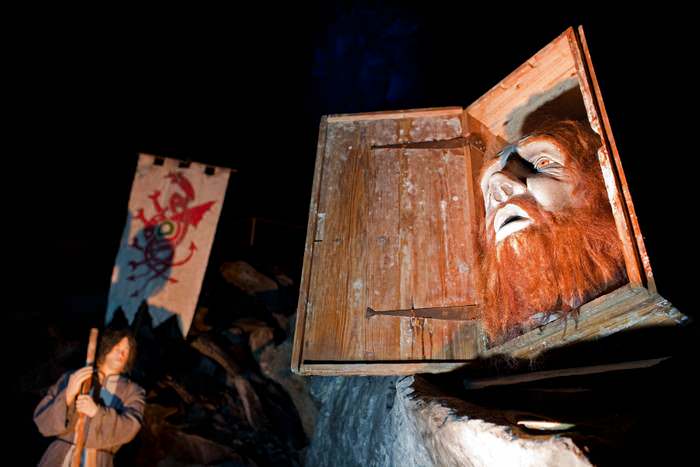
Bran the Blessed’s head had been buried in the White Mount in London, and its supernatural powers protected Britain from invasion. Photo: Courtesy of King Arthurs Labyrinth
We continue winding our way through the dark tunnels from scene to scene, lit only by sporadic lamps. It’s atmospheric and a little claustrophobic at times, but lots of fun.
While we’re walking along, I ask our guide about the mines and learn that many of the slate mines were worked for more than 130 years. The shaft we’re walking through is an access tunnel to the main vein, and we’re on the old level-6 tramway that was opened in 1850. Flooding this level in 1994 created the river that we crossed in our longboat.
The slate of this stratum that we’re walking through, called the Appendix Vein, was formed from Ordovician mud deposits, 500 million years ago. Volcanic action hardened it, making the slate dense and pure, thus ideal for slab production. By the 1970s the slate mines were all closed, and the ones at Braich Goch were later opened up as a tourist attraction.
Our next stop is at a diorama of The Battle of Camlam where we continue King Arthur’s epic. Arthur has killed his enemy Sir Mordred, but is mortally wounded. In this well-known tale, Arthur asks Sir Bedwyr to take his sword and throw it into the lake. Bedwyr, not wanting to waste a perfectly good sword, hides it and lies to Arthur. Arthur, who clearly knew his subordinates well, twice more asks Bedwyr to throw the sword in the water. On the third throw, as we know, the hand of the Lady of the Lake appears to take the sword.
Bedwyr describes this to Arthur, who now knows that Bedwyr is telling the truth. A boat with three maidens appears to carry Arthur to the Vale of Avalon where his wounds will be healed. The final Labyrinth scene shows King Arthur and his men lying asleep under the mountain, surrounded by their treasure of gold and silver. They will lie here until they are called to help The Cymru—The Welsh—in their time of mortal danger.
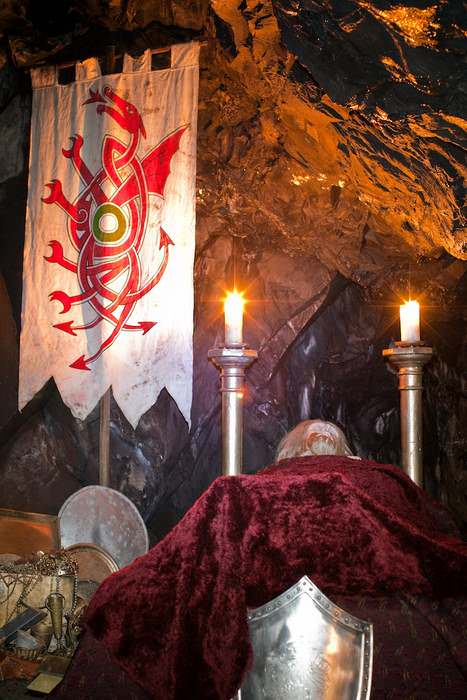
The final Labyrinth scene shows King Arthur and his men lying asleep under the mountain, surrounded by their treasure of gold and silver. They will lie here until they are called to help The Cymru—The Welsh—in their time of mortal danger. Photo courtesy of King Arthurs Labyrinth
It seems a fitting and comforting end to the King Arthur’s Labyrinth—knowing he and his men are out there somewhere lying under a mountain, waiting to be called to arms.
We return to the longboat and are carried back to our own time, emerging blinking and squinting into the bright daylight. Although this tour is more of a tour through Welsh folklore than an official mine tour, it still shows what it was like to work in these dark shafts. And you certainly get an idea of how deeply these mines penetrate the mountain. Although our tour was only a half-mile long, it seemed like it went for miles!
Another tour, for mining aficionados, the Corris Mine Explorers tour, also penetrates the depths of the Braich Goch Mountain slate mines, giving an insight into Welsh slate mining back in the day.
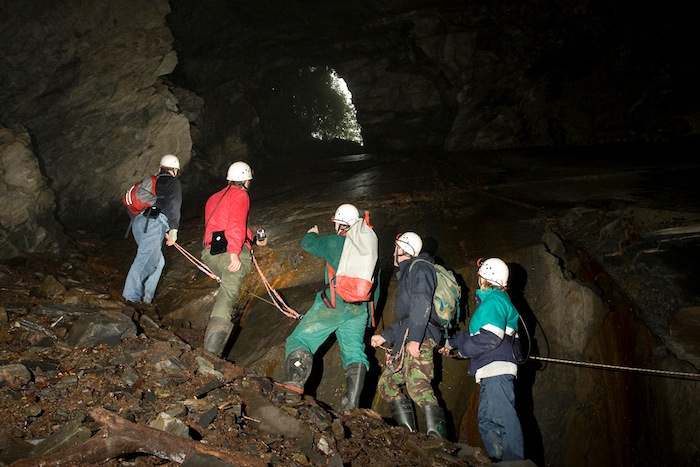
The Corris Mine Explorers tour, also penetrates the depths of the Braich Goch Mountain slate mines, giving an insight into Welsh slate mining back in the day. Photo: Courtesy of King Arthurs Labyrinth
After visitors are kitted up with a helmet, safety harnesses, and a cap lamp and battery pack, they enter the abandoned slate mine. The guide, Mark Waite, has spent many years researching and exploring abandoned Welsh mines. Considered one of the country’s top mine explorers, Mark delights in telling the visitors about Welsh mining and social history.
Whether you choose King Arthur’s Labyrinth or the Mine Explorer’s tours, you’ll enjoy your walk through these storied old Welsh mines. Their very walls seem to emanate the ringing of hammer on slate and the rough Welsh talk of the hardy miners.
King Arthur’s Labyrinth
Corris, Machynlleth, Powys, SY20 9RF
Email: info@kingarthurslabyrinth.co.uk
Open Daily 10am. from March 31 to November 2.
You are advised to book in advance by Internet
Written by Roy Stevenson for EuropeUpClose.com

